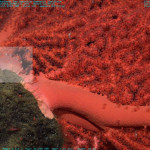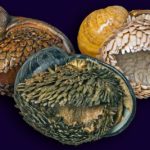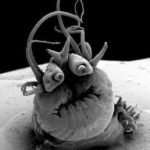From Monterey Bay Aquarium Research Institute…In the ocean, there are places where it looks like it is snowing. These magical places are near undersea volcanic activity. The snow particles are clumps of bacteria that use chemicals to make food. Chemicals they use include hydrogen sulfide, which is toxic to virtually all other life. Most other ecosystems on earth depend on organisms that require sunlight to create food. Vents release hot water, minerals, and chemicals from beneath hardened lava. The fluid is almost 30 degrees F warmer than the surrounding water. The bacteria live beneath the seafloor and are also released from the vent. These tiny one-celled microbes provide food for many animals. A thick mat of white bacteria builds up; little worms and crustaceans feed on it. Nearby, “black smoker” vents may form when vents spew minerals in water up to 750 degrees F. In time, an amazingly robust community with thousands of animals flourishes here. This video was recorded 480 km (300 miles) west of the Oregon coast at 1,516 m (4,974 ft) depth with remotely operated vehicle Doc Ricketts.
One Reply to “TGIF: Marine Snow”
Comments are closed.






Of course the first thing that came to mind was: http://www.drsfostersmith.com/product/prod_display.cfm?pcatid=19703
That being said, what sort of calendar would one observe, if one spent one’s days entirely beneath the surface of the sea? Has anyone devised a calendar comprised of migrations, algal blooms, el niño/la niña, coral spawns, breeding cycles, and the like?